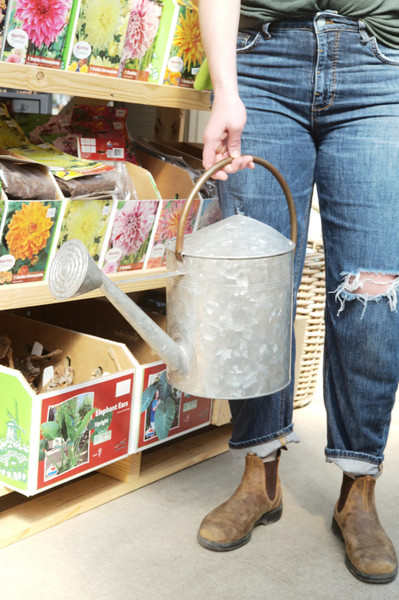Early Spring Garden Checklist
Posted by Jessie Jacobson on Mar 27th 2025
Early Spring Garden Checklist
Spring! It's finally here and it's time to get growing in the garden. Check out our early spring gardening checklist. Let's dig!
Get your tools in order
Get your tools sharpened. We recommend the Sharpening Center in Downtown Hopkins. However, if you don’t have tools, you might want to purchase some essentials before they disappear from a shelf near you. Look! We made a shopping list!
Prune panicle hydrangeas and shrubs that bloom on new wood
Pruning is important to overall plant health, appearance, and maintenance of your shrubs natural shape. Pruning promotes fresh growth, encourages flowering, and fruit development. Pruning shrubs, especially before they even start to grow can be a bit overwhelming at first, but with a little basic knowledge, you’ll be on your way! And wouldn’t you know, we have resources prepared for you!
Check out this blog and this video from the archives to show you how.
Wait as long as you can to start spring clean-up
Ideally you should wait until the daytime temperatures are consistently about 50 degrees for 7 days in a row before beginning spring cleanup. This allows for the soil to warm up and dry out which is best for soil structure as you begin to dig and walk in the garden. Our pollinator friends and beneficial insects will thank you too as they are still in diapause (a fancy name for a long winter nap). Did you know native bees, lacewings, and parasitic wasps overwinter in hollow plant stems? Check out this blog as you begin to garden with pollinators in mind!
Prepare to repel
Those pesky deer, rabbits, and other problem creatures are up and running. Applying repellents early and often, especially as new growth starts to emerge, helps establish boundaries which are good for everyone. In the case of deer, they are pattern eaters, so letting them know your garden isn’t their lunch truck allows them to set a different pattern, making it less likely they’ll visit your space in the future. Repellents should be rotated, as some critters (such as deer, rabbits, squirrels…) will begin to tolerate one that is used repeatedly. Try Liquid Fence as a spray or granule application, Bonide Repels-All, Shake Away, and Repellex which is a systemic repellent in tablet form. The critters – they’re tricky. You must be trickier. Check out this blog for more information!
Top dress with compost
Top dressing gardens with compost allows the spring rains to do the work for you. Rather than raking it in - let the rain filter compost goodness into the soil. This hands-off approach allows for less soil upheaval and tillage, which can compromise soil structure and the soil biome while also causing compaction.
Purple Cow Organic Activated Compost is an excellent addition to every type of garden, especially when growing herbs, veggies, and fruits. Full of microbial life that metabolizes nutrients and makes them more readily available to hungry food crops, this compost will make everything grow bigger, stronger, and more productive. Flowers, trees, and shrubs love it, too! We recommend 1 cu. ft. (or 1 bag) per 10 sq. ft. of soil.
Go after the weeds
Get a jump on weeding by applying Preen. Preen prevents annual weeds seeds from germinating (sorry folks, it doesn’t work on perennial weeds like dandelions and thistle) so there is no need to kill or pull them later. Apply Preen when the soil is dry. Water in and do not disturb to give it time to do its thing. It works wonders, but be sure to read and follow the directions carefully. Try Preen Garden Weed Preventer for flower beds and Preen Vegetable Garden Organic Weed Preventer for edible plants.
When weeds happen in the lawn, and they will, go for Bonide's Weed Beater Ultra in a hose end sprayer, single hand sprayer, or ready to use large pump sprayer. It’s a superior performer, even down to 45 degrees, and once dry will continue to work even after a rain.
Plant Summer Blooming Bulbs Indoors
Dahlia tubers, and elephant ear bulbs have arrived. We can’t plant them out just yet, but they’re easy to keep until it’s time. Just store in a cool, dry place out of direct sunlight. Plant outside once danger of frost has passed and soil temperature has reached at least 50 degrees. To get a head start, pot them up, water them in, and place in a sunny window indoors. Move outdoors when the weather allows. Check out this blog for our expanded guide to staring dahlia tubers indoors.
Start Seeds
If you haven’t started your tomatoes and peppers, run don’t walk to the nearest seed rack! Not to worry, though, we will have plenty starter plants for sale in May should you not get your seed starting operation up and running in time. There is still lots of time to start flowering annuals, cucurbits, herbs, and more. Here are a few great seed starting resources for your reading and viewing pleasure.
Plant your pansy pots
Their shiny faces are here and are ready to please even when temperatures dip down a bit below freezing.

